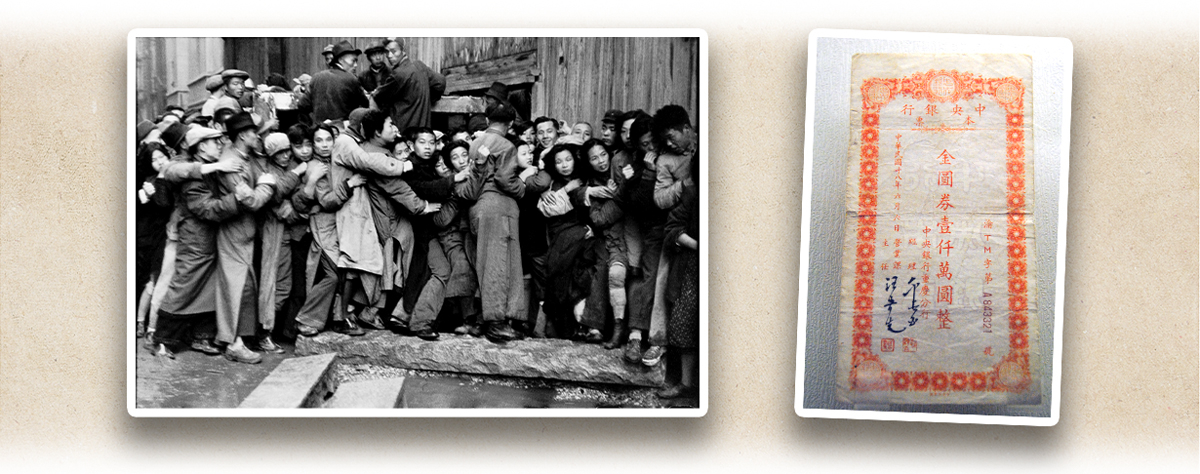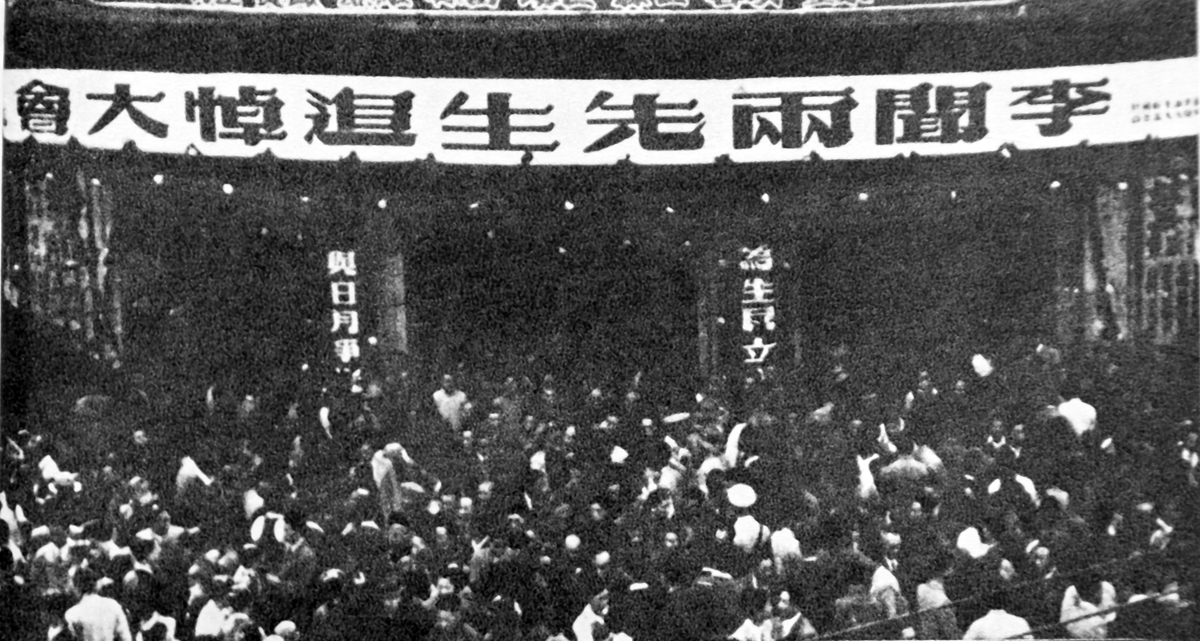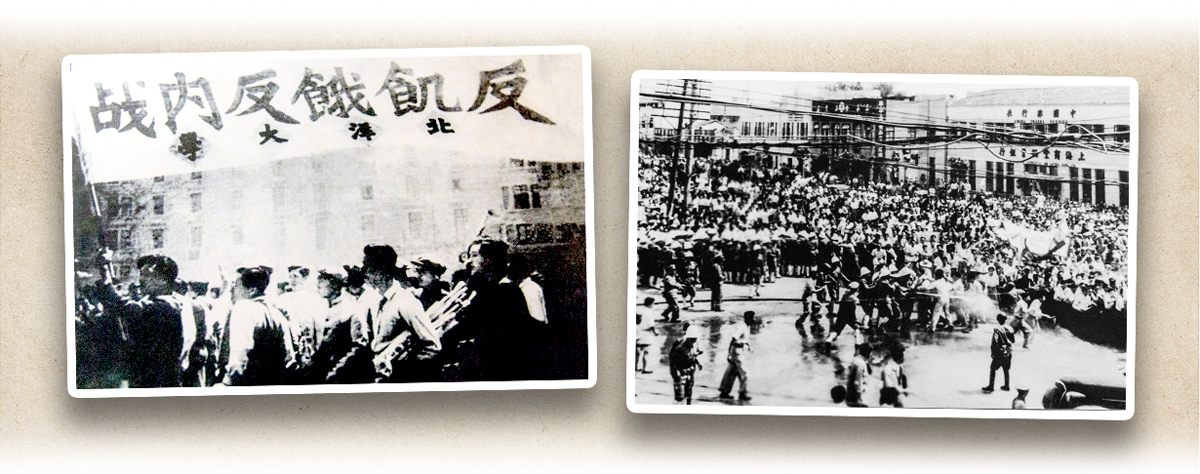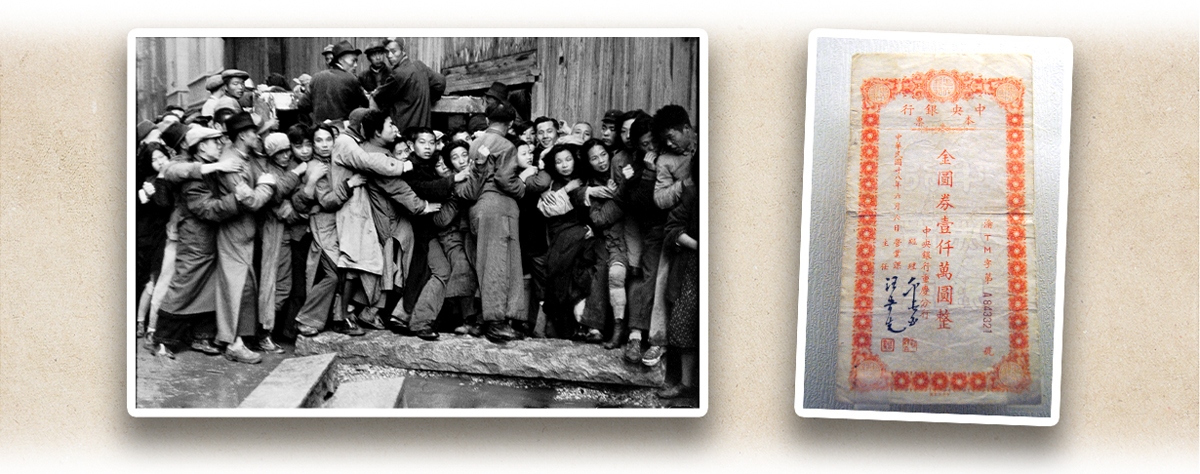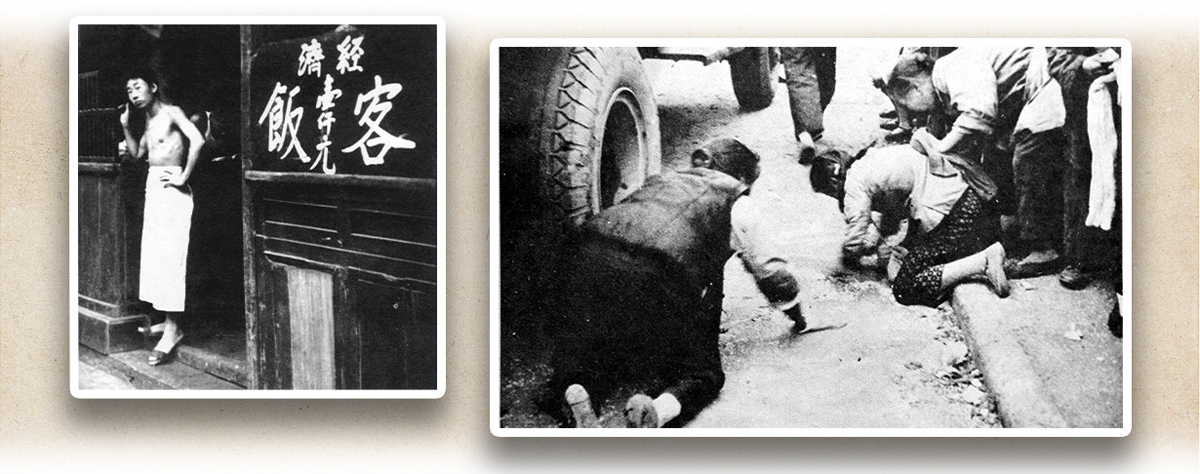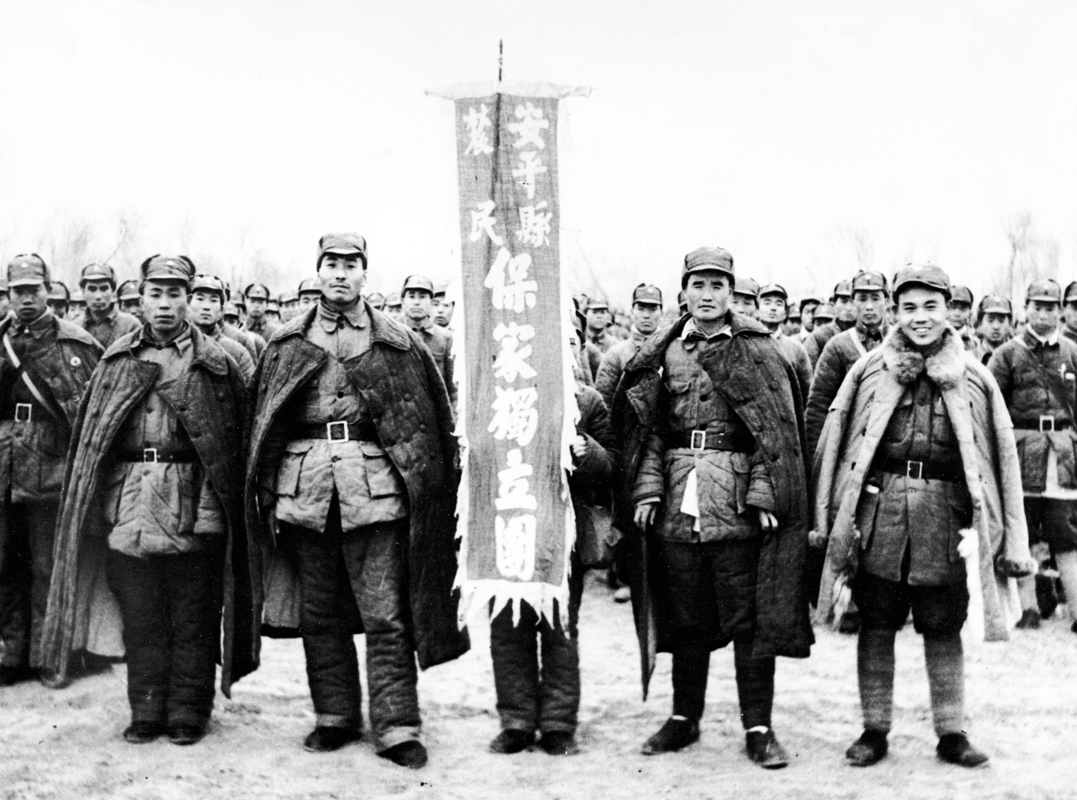In addition to military defeats on the front line, the economic and social situation in the Government-controlled areas went downhill as well. Inflation was already on the rise during the War of Resistance Against Japanese Aggression. When the war ended, the committees dispatched by the Nationalist Government for the takeover embezzled public assets. Coupled with reasons including the outbreak of the civil war, scarcity of daily supplies, and inflation were further aggravated. In addition, the civil war pushed up military spending. Unable to make ends meet, the Government issued the Gold Yuan (金圓券) in 1948, compelling the public to exchange their gold and foreign currency for this new currency. The practice only devalued the Gold Yuan and fuelled inflation out of control.
Initially, the Government intended to issue 2 billion worth of Gold Yuan. However, by June 1949, there were 130.3 trillion yuan of Gold Yuan in circulation, resulting in a ten-thousand-fold devaluation which crushed the economy and public life. Back at the end of 1945, the Government had USD 900 million of gold, silver dollars, and foreign currency in its reserve. In April 1948, its foreign reserve was a mere USD 110 million. Corrupted officials and profiteers catalysed the deterioration of the economy. Chiang Kai-shek’s (蔣介石) son, Chiang Ching-kuo (蔣經國), went to Shanghai (上海) to supervise the regulation of price and the crackdown on profiteers. However, he left the city fruitless as his hands were tied in front of bureaucratic capitalism backed by political powers.
Faced with a sliding economy and dire poverty, the public turned against the Government. On 4 May 1947, Shanghai students held demonstrations demanding “food, peace, and freedom” and “anti-hunger, anti-civil war, and anti-persecution”. Students and civilians in big cities, including Nanjing (南京), Beiping (北平, now Beijing﹝北京﹞), Tianjin (天津), Wuhan (武漢), Hangzhou (杭州), and Nanchang (南昌) followed suit. Another reason for the public resentment was the Government’s secret agents targeting dissidents. Infamous incidents included the murder of Li Gongpu (李公樸) and Wen Yiduo (聞一多), both advocators of democracy, in Kunming (昆明), Yunnan Province (雲南), in 1946. In the second half of the 1940s, the Chinese Communist Party (CCP, 中國共產黨) viewed the continuous student movements and public protests as a force on its side with the People’s Liberation Army (PLA) fighting the Kuomintang of China (KMT, 中國國民黨).
|
|
The KMT led China to victory in the War of Resistance. Its post-war military strength was still obvious. Why did it fall apart just two to three years into the civil war? |
|
|
See answer below. |
The hyperinflation in China during the second half of the 1940s was rarely seen in global financial history. Inflation triggered by scarcity of daily supplies and over-issue of currency was already a threat during the War of Resistance and the situation deteriorated quickly during the civil war with major cities such as Shanghai being the worst affected. Left: a resident in the temporary capital of Chongqing (重慶) moving a sack of banknotes by a rickshaw in October 1945. Right: a cartoon depicting Shanghai civilians exchanging US dollars, drawn by Friedrich Schiff, an Austrian painter sojourning in Shanghai from 1929 to 1947 portrayed the kaleidoscope of life in old Shanghai with his comic drawings. After the full-scale civil war broke out, currency depreciation prompted residents in the Government-controlled areas to exchange for US dollars and buy gold.
The people of Shanghai holding memorial services for Li Gongpu and Wen Yiduo, two respected intellectuals who were murdered by KMT secret agents in Kunming in July 1946. Many intellectuals lost faith in the Government because of its persecution of dissidents after the War of Resistance, which triggered waves of protests.
Before the Gold Yuan appeared in 1948, people in China were already tormented by the civil war, currency depreciation, and food shortage. The photos show the “anti-hunger, anti-civil war, anti-persecution” student movements that spread nationwide in May 1947, which were echoed by the public. Student movements and social protests formed a front in the civil war that weakened the Government’s rule.
Civilians in 1947 parading in anti-profiteers protests. Hyperinflation soared in China after the War of Resistance. Despite social miseries, profiteers speculated on the market and hoarded crucial supplies, which worsened livelihoods and angered the public. Kung Ling-kan (孔令侃), son of Kung Hsiang-hsi (孔祥熙) and Soong Ai-ling (宋靄齡), operated the Yangtze Development Corporation since 1946 in Shanghai. With his prominent background, the company exploited huge profits during the civil war and was seen as a typical example of bureaucratic capitalism.
Soong Ai-ling, the eldest of the prominent Soong sisters in the Republican period, married Kung Hsiang-hsi. The second of the sisters, Soong Ching-ling (宋慶齡), married Sun Yat-sen (孫中山) and the youngest, Soong Mei-ling (宋美齡), married Chiang Kai-shek. Kung Hsiang-hsi was a key figure in the political and financial sectors. He served as Governor of the Central Bank of China, Minister of Finance, and Premier of the Executive Yuan (行政院). He was also the Chairman of the Bank of China from 1944 to 1948. Their son Kung Ling-kan was greedy for wealth and luxury but still enjoyed Soong Mei-ling’s favour. In January 1946, the Yangtze Development Corporation (Yangtze Corp. for short) was formed and the 30-year-old Kung Ling-kan was responsible for its operation. The company took advantage from its political background to gain a monopoly of import quotas for important commodities including automobiles, electronics, medicines, and luxuries. It also captured a windfall by hoarding and tax evasion. The Yangtze Corp. was symptomatic of the bureaucratic capitalism prevailing among officials and dignitaries who formed a rentier network in the political and business circles. Bureaucratic capitalism disrupted normal market operation and vanquished private businesses, leaving society and the economy in ruins and the people in anger.
In August 1948, the Government enacted a currency reform to replace fabi (法幣, legal currency issued by the banks of the Government) with the Gold Yuan. The public was ordered to exchange gold, silver dollars, and foreign currency for the Gold Yuan. Upon the introduction of these measures, currency depreciation and inflation rocketed. Left: as the value of the Gold Yuan evaporated in 1948, Shanghai civilians rushing to buy gold. Right: a ten-million Gold Yuan note issued in June 1949.
In China’s financial centre of Shanghai in April 1949, the exchange rate was USD 1 to 95,000,000 Gold Yuan. The official exchange rate between the Gold Yuan and the silver dollar was 4,000,000 to 1 and 9,000,000 to 1 on the market. Meanwhile, the Gold Yuan continued to depreciate to the point where it was nothing but a scrap paper.
Photos from the hyperinflation period. Left: a value meal costing 1,000 yuan. Right: people scrambling for spilled rice on the ground.
Photos of Shanghai during the hyperinflation period show swarms of people queuing for staple foods (left) and protesting the soaring food price and food shortage (right).
From August to November 1948, Chiang Kai-shek sent his son Chiang Ching-kuo to Shanghai to stabilise the economy. Chiang Ching-kuo took concrete measures to regulate price and punish profiteers in the campaign called “fighting tigers in Shanghai”. However, even Chiang Ching-kuo could not rein in bureaucratic capitalism. Left: Chiang Ching-kuo raising his fist to show his resolution in “fighting the tigers”. Right: During the campaign, some profiteers were executed.
Chiang Ching-kuo was aware of how Kung Ling-kan’s Yangtze Corp. and its kind wrecked the economy and infuriated the people the most, and he was determined to hold them accountable. In September 1948, the fraudulent practices of the Yangtze Corp. were exposed and in October, Chiang Ching-kuo ordered two thorough investigations into the company. The incident was known as “the Yangtze Corp. case”. However, Soong Mei-ling persuaded Chiang Kai-shek into halting the investigation and the case went without being addressed. Soon, a dismayed Chiang Ching-kuo left Shanghai. The last hope of rebuilding the economy vanished. The economic collapse was a key factor for the KMT’s loss in Mainland China.
Before the PLA took Shanghai, Kung Ling-kan had transferred his assets offshore. He later lived an affluent life in the United States. In Chiang Kai-shek and I, the author Zhou Hongtao (周宏濤) who served as Chiang’s aide and confidential secretary between 1943 and 1958 wrote that in the early 1970s, Chiang Ching-kuo was the Premier of the Executive Yuan of the Government in Taiwan (台灣). When he was to form cabinet, Soong Mei-ling recommended Kung Ling-kan, who lived in the United States at the time, for the position of the Minister of Finance. The recommendation was shelved because Chiang Ching-kuo strongly disapproved of Kung.
For the CCP however, the Liberated Zones covered mostly rural areas. Compared with the Government-controlled cities, the Liberated Zones enjoyed better social and economic stability because of its simplicity. As the civil war intensified, the CCP carried out a comprehensive land reform in the Liberated Zones to rally farmers’ support. More specifically, the CCP confiscated land from landlords and redistributed it to farmers. Left: on 4 May 1946, the CCP Central Committee issued a directive on the land reform where the policy of reducing rent and interest was replaced by the redistribution of land confiscated from landlords. Right: on 10 October 1947, the Outline of Chinese Land Law was released. The land reform was in full swing in the Liberated Zones.
In March 1948, an independent regiment formed by farmers from Anping County (安平縣), Hebei Province (河北), was ready to fight the KMT on the front line. Land problem was at the core of economic issues in rural areas. The CCP’ s land reform granted farmers ownership of land confiscated from landlords. Therefore, more farmers were willing to safeguard their home and property by enlisting or joining supportive groups such as stretcher teams. Also, they voluntarily paid higher tax in grains. The farmers’ involvement played a key role in the CCP’s victory.
|
|
The KMT led China to victory in the War of Resistance. Its post-war military strength was still obvious. Why did it fall apart just two to three years into the civil war? |
|
|
The KMT’s defeat could be attributed to many factors including the soldiers’ fatigue of war, the Government’s exorbitant levies, corrupt government officials, malfunctioning fiscal policies, and economic collapse. China was a country of farmers and the flawed land policies deprived them of land and food. Meanwhile. Most KMT soldiers came from farming families and the plight back home dealt a blow to the troops’ morale. There were also cliques within the KMT forces based on which division a soldier belonged to. As a result, some troops were discouraged to fight with full strength. Others rather surrendered to the PLA for its more inclusive tone. By contrast, the CCP’ s land reform in the Liberated Zones motivated farmers to join the army to protect the farmland they owned and civilians turned in grains to support the CCP on the front line. Statistics show that in 1949, the CCP received 30.4 billion jin (斤) of grains worth USD 1.1 billion. The Government’s fiscal revenue that year was just USD 90 million. With fiscal revenue 12 times that of the KMT’s, the CCP was able to strengthen its military and seal victory swiftly. |
Source of most photos used in this feature piece: Fotoe.




